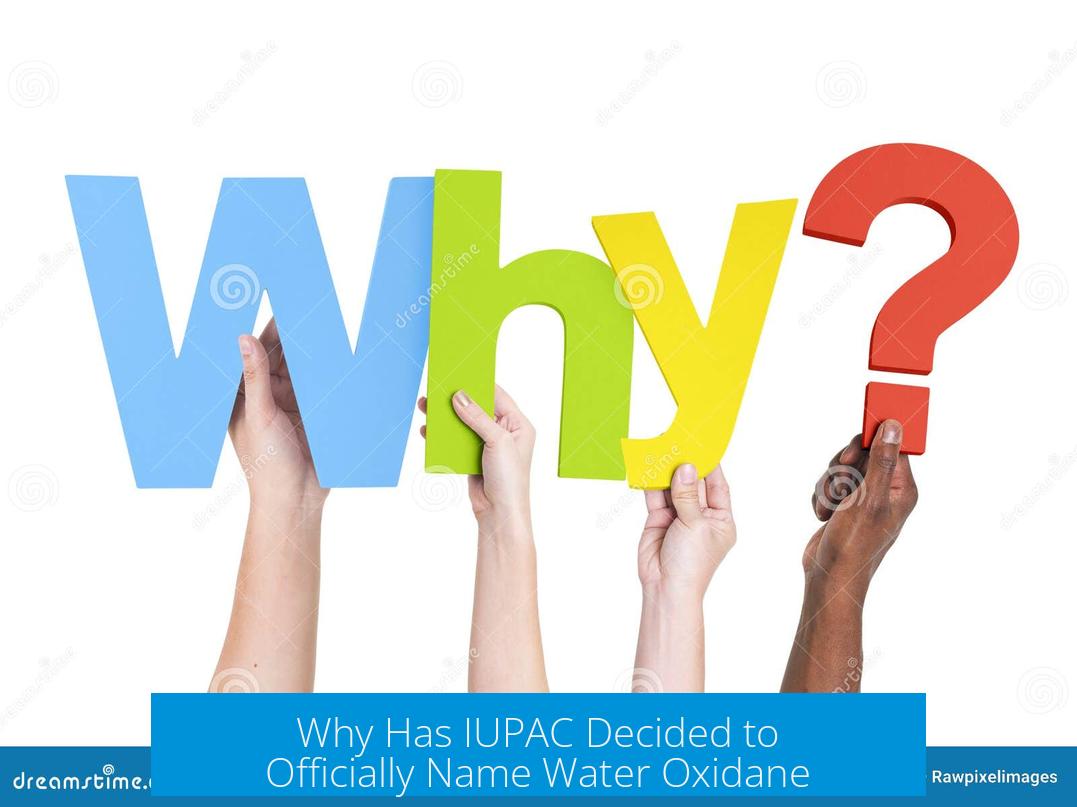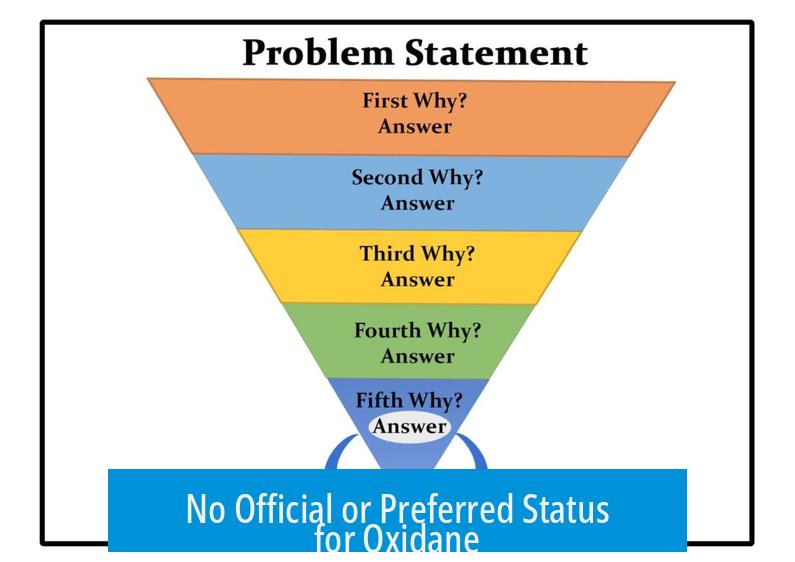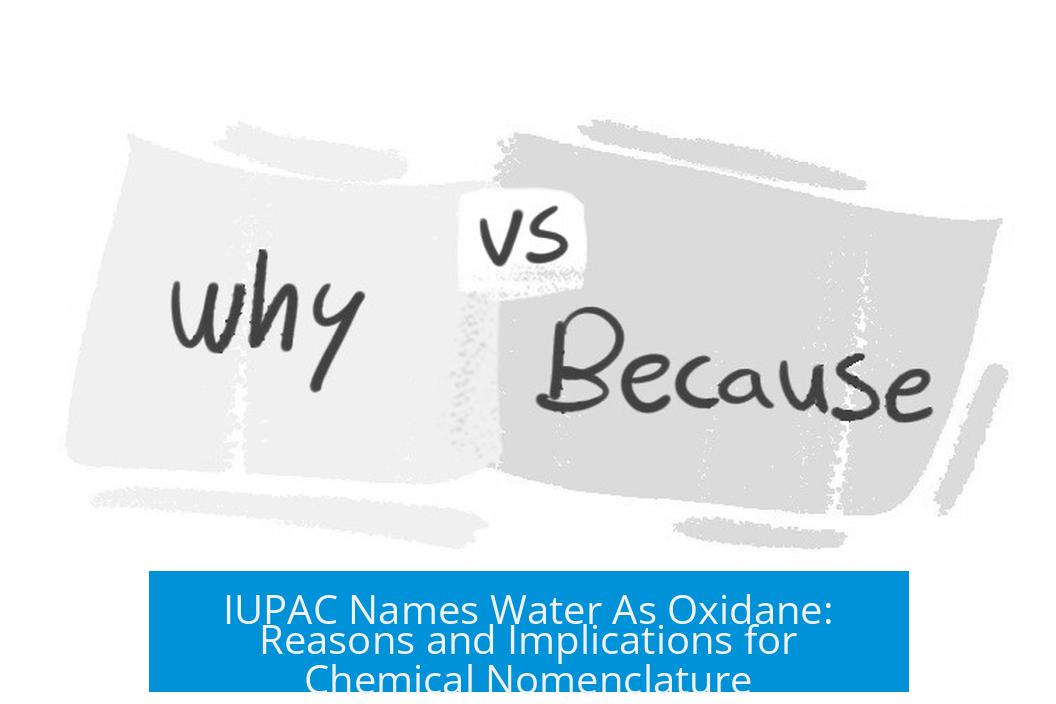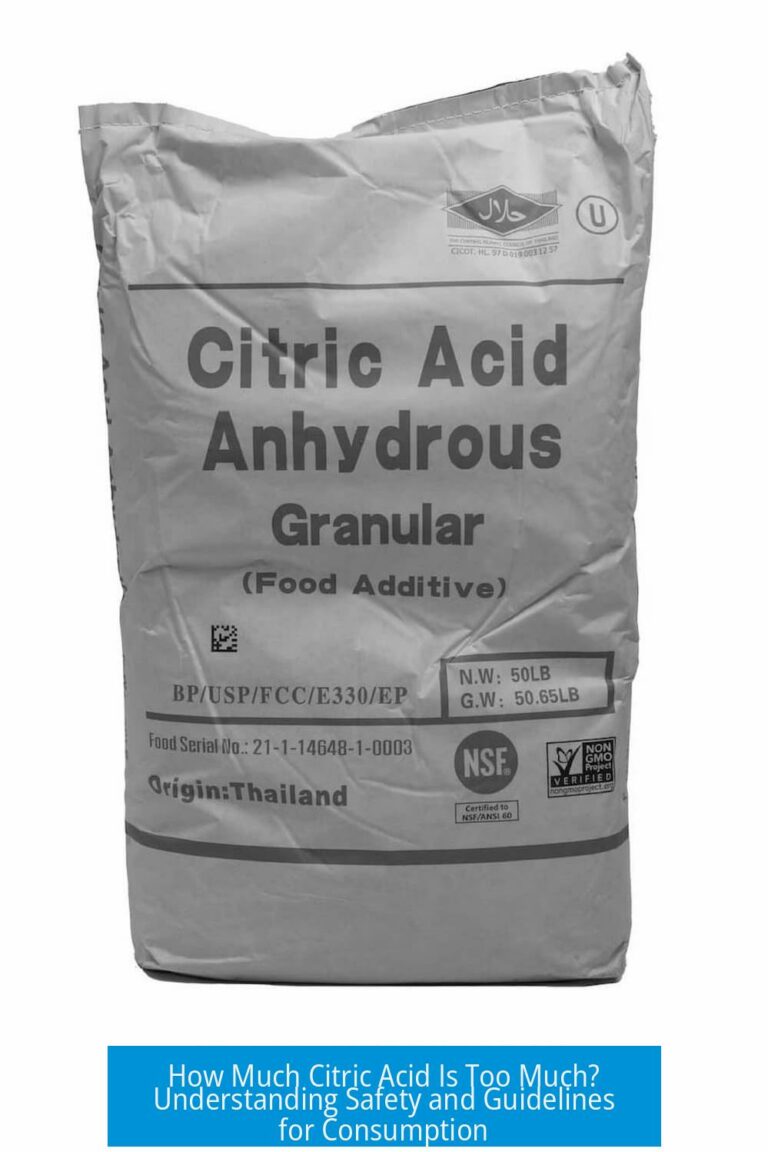Why Has IUPAC Decided to Officially Name Water Oxidane?

IUPAC introduced the name “oxidane” primarily to provide a systematic base name for derivatives of water used in specialized chemical nomenclature, particularly in naming polynuclear compounds. However, this name is not intended to replace the common name “water,” and IUPAC has not designated oxidane as the official or preferred name for H2O.
Basis for Naming Water Derivatives
IUPAC uses “azane” and “oxidane” in substitutive nomenclature as foundational names. “Azane” refers to ammonia derivatives, while “oxidane” targets water derivatives.
- Oxidane facilitates naming complex polynuclear compounds involving water, such as dioxidane (H2O2).
- This systematic approach supports clarity in organic and inorganic chemical names where water units are components.
No Official or Preferred Status for Oxidane

The IUPAC Red Book clarifies that it does not prescribe “oxidane” as the official or preferred name for water. It allows the continued use of the common name “water” in documentation and communication. This demonstrates IUPAC’s recognition of existing widespread usage and clarity.
Nomenclature Context: Organic vs. Inorganic Chemistry
Water is not considered an organic compound, so organic nomenclature rules (Blue Book 2013) do not apply. While IUPAC tentatively uses “water” for H2O, the assignment of preferred IUPAC names (PINs) for common inorganic compounds like water remains pending.
This deferral means water lacks a formal PIN in the current guidelines, leaving traditional naming intact.
Current Position and Outlook

IUPAC currently leans toward retaining “water” as the accepted name for H2O. There has been no unambiguous decision to make “oxidane” the standard. The next update of official recommendations may clarify this.
Until then, oxidane remains primarily a technical term helping to systematize water derivatives rather than a replacement for the everyday name.
Key Takeaways
- Oxidane is a systematic base name to name water derivatives in chemical nomenclature.
- IUPAC does not mandate oxidane as the official or preferred name for water.
- Common usage of “water” prevails in both organic and inorganic contexts.
- Preferred IUPAC name for water is pending further recommendations.
- Oxidane serves mainly as a tool in naming polynuclear and substituted water compounds.
Why Has IUPAC Decided to Officially Name Water Oxidane?
To clear up a confusion swirling around chemistry circles: IUPAC has not officially renamed water as “oxidane.” Instead, they introduced “oxidane” as a systematic, technical term to serve as a base for naming derivatives of water within a specialized naming system. In everyday language—fear not—we still just say “water.”
That sounds straightforward, right? But let’s dive deeper into the reasoning and unravel why this playful yet precise word “oxidane” exists in the world of chemical naming, and what roles it plays beyond just being a fancy synonym for H2O.
The Birth of “Oxidane”: A Naming Tool, Not a New Name
The chemists at IUPAC (International Union of Pure and Applied Chemistry) introduced “oxidane” primarily as a base name for naming derivatives of water using substitutive nomenclature. This means when water molecules link or modify into more complex structures—such as polynuclear compounds—scientists need a reliable linguistic anchor. Oxidane fills that role.
For example, in compounds like dioxidane, which features two linked oxygen atoms bridged by hydrogen atoms, “oxidane” forms the stamp of origin. This use is akin to how “azane” serves as the root for ammonia derivatives in naming protocols. Without such base words, the systematic naming of complex molecular structures would get tangled quickly.
Here’s what this looks like: “Oxidane” is not meant to replace “water” on your grocery list or in your laboratory notes—it’s a technical scaffold. Think of it as chemistry’s legalistic term for water when it’s part of a bigger compound. IUPAC’s Section IR-6.4 and their Table IX elaborate on this usage.
Why Isn’t “Oxidane” the Official Name of Water?
Despite the existence of “oxidane,” the IUPAC Red Book—essentially the bible for chemical names—does not label it as the official or preferred name for H2O. The simple, beloved “water” still stands firm. And yes, you can ctrl+F “water” in the Red Book and find it there, standing its ground.
The Red Book specifically avoids forcing chemists or students to swap everyday names for cold, unfamiliar alternatives. Instead, it embraces the stability of traditional names like “water” and “ammonia,” pending future developments.
Organic Versus Inorganic Chemistry: The Naming Divide
Why does this naming tussle exist? It partly boils down to the divide between organic and inorganic chemistry nomenclature.
Water is not an organic compound. The Blue Book (IUPAC’s guide dedicated to organic compound names) doesn’t officially single out a preferred name for water either. It opts to keep the common name “water” without introducing “oxidane” as a preferred name. This deferral awaits a future recommendation on inorganic name preferences.
So right now, water hangs out in a limbo of sorts—widely accepted as water, but with a technical alter ego ready on call for specific naming needs.
Is “Oxidane” Here to Stay? The Future Outlook
At this moment, IUPAC leans strongly toward keeping water as “water.” No official overthrow of the common name is planned. However, the door remains slightly open. Updates to IUPAC’s Red Book might one day formally select official preferred names for key inorganic substances like water. Perhaps “oxidane” will rise to more formal use then.
Until then, think of “oxidane” like the secret code name for water used behind the scenes in special naming cases. For typical science labs, classrooms, and daily references, “water” reigns supreme.
Why Does This Matter to You?
Okay, you might ask: Why should anyone care about such an obscure term? Here’s why it’s worth knowing:
- Technical Precision: For chemists dealing with polynuclear compounds, derivatives, or advanced substitutive nomenclature, “oxidane” ensures naming clarity and consistency.
- Educational Insight: Understanding the difference between common and systematic names sharpens scientific literacy.
- Communication Ease: In technical documentation or chemical publications, proper systematic names prevent confusion.
To Recap: What You Really Need to Know
| Fact | What It Means |
|---|---|
| IUPAC created “oxidane” for naming water derivatives. | Serves as a base in complex chemical naming, not a common name for water. |
| “Oxidane” is not an official or preferred name for water. | “Water” remains valid and widely accepted. |
| Water is not included in organic nomenclature systems. | Common names like “water” are accepted pending further naming recommendations. |
| IUPAC may revisit the preferred naming conventions in future publications. | “Oxidane” might gain official status someday, though no plans exist currently. |
Final Thoughts
The introduction of “oxidane” may seem like chemistry’s attempt at highbrow jargon, but it fills a real, practical role in scientific naming. This approach lets chemists talk precisely about water’s more complex relatives while users worldwide keep calling H2O just “water.”
So next time someone claims you must say “oxidane” instead of water, remember: the International Union of Pure and Applied Chemistry has not sent that memo. For now, the everyday, crystal-clear “water” still flows freely.
Why did IUPAC introduce the name “oxidane” for water?
IUPAC created “oxidane” as a base name for naming water derivatives. It helps name complex compounds like dioxidane using substitutive nomenclature.
Is “oxidane” the official preferred name for water according to IUPAC?
No. IUPAC does not mandate “oxidane” as the official name. The common name “water” remains widely accepted and used in the Red Book.
Why doesn’t IUPAC assign a preferred IUPAC name (PIN) to water yet?
Water is not an organic compound, so it’s outside organic nomenclature rules. IUPAC is deferring official PINs for common inorganic names like water until future recommendations.
Will “oxidane” replace “water” in the future as per IUPAC?
Currently, IUPAC leans toward keeping “water.” There is no clear decision yet, but a formal update could happen in future Red Book editions.
What is the main role of the name “oxidane” within chemical nomenclature?
“Oxidane” is mainly a technical term used to name derivatives and polynuclear compounds containing water. It’s not meant as a general replacement name for H₂O.





Leave a Comment